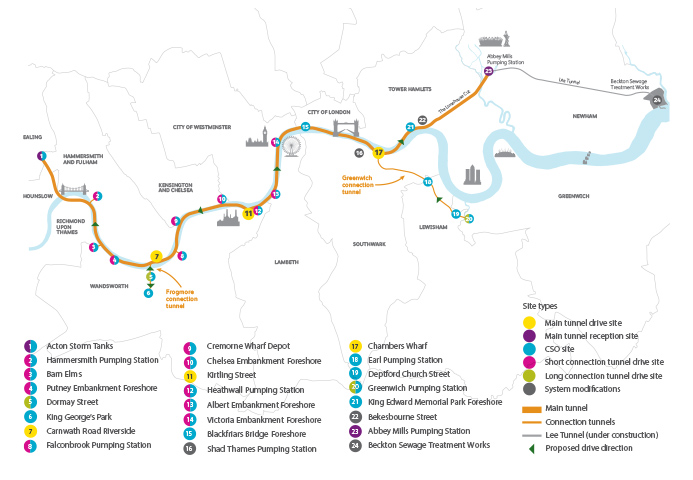Public sewer

|
| The Thames tideway tunnel comprises a 24km long 7.2m diameter sewer running from Acton in the west to Abbey Mills in the east. It will have a holding storage capacity of 1.6 million cubic metres. |
A pipe that serves only one property is referred to as a drain. Drains are privately owned and maintained as far as the boundary of the property. Beyond the boundary of the property a drain is referred to as a public lateral drain.
A pipe that serves more than one property is referred to as a sewer. Sewers that connect to the public sewer network are referred to as public sewers.
The sewer system, that is, the underground network of pipes that carries sewage (waste water and excrement), other waste water and surface water run-off, from properties to treatment facilities or other disposal points is referred to as sewerage.
Under the Public Health Act 1936 all sewers (as defined by the Public Health Act 1875) which were in existence on 1 October 1937 became public sewers. After 1937 new sewers were only public if they were laid or adopted by the sewerage undertaker.
However, on 1 October 2011 in England and Wales, private sewers and lateral drains that were connected to the public sewer before 1 July 2011 were transferred to the ownership of the regulated sewerage companies (generally water companies).
It is possible to apply for new or existing sewers or lateral drains to be adopted by a sewerage company. For more information see:
Public sewers usually run under roads or public open spaces, but they may also run through private property such as gardens. The sewerage company has a right of access to these public sewers in order to maintain them.
Permission is required from the sewerage company to build over a public sewer. Failure to obtain permission may result in the withholding of a building regulations completion certificate.
It is also possible to have public sewers diverted under Section 185 of the Water Industry Act.
The route of existing mapped public sewers can be determined by inspecting local authority records or by contacting the local sewerage company. There may also be details in property deeds. However, many public sewers are not mapped. In this case, it may be necessary to carry out inspections from manholes, to undertake an electronic sewer trace or to dig trial holes.
- A surface water drain or sewer is a pipe that carries only surface water, not foul water.
- A foul water drain or sewer is a pipe that carries waste water from a property such as from a toilet, bath, washing machine and so on. Surface water should not discharge into a foul water drain or sewer, as this can cause flooding of foul water.
- A rising main is a pressurised sewer that can be used to pump foul or surface water.
[edit] Related articles on Designing Buildings
- Cesspool.
- Clarified water.
- Difference between drains and sewers.
- Drainage.
- Drains.
- Grease management.
- Manhole.
- Private sewer.
- Public Health Act 1875.
- Safe working in drains and sewers.
- Sanitary pipework.
- Section 102 existing sewer adoption.
- Section 104 new sewer adoption.
- Septic tank.
- Sewer construction.
- Sewerage.
- Sewerage company.
- Sustainable urban drainage systems SUDS.
- Thames Tideway Tunnel.
- The redevelopment of Leicester's sewerage system by Joseph Gordon.
- Waste water.
Featured articles and news
Latest Build UK Building Safety Regime explainer published
Key elements in one short, now updated document.
UKGBC launch the UK Climate Resilience Roadmap
First guidance of its kind on direct climate impacts for the built environment and how it can adapt.
CLC Health, Safety and Wellbeing Strategy 2025
Launched by the Minister for Industry to look at fatalities on site, improving mental health and other issues.
One of the most impressive Victorian architects. Book review.
Common Assessment Standard now with building safety
New CAS update now includes mandatory building safety questions.
RTPI leader to become new CIOB Chief Executive Officer
Dr Victoria Hills MRTPI, FICE to take over after Caroline Gumble’s departure.
Social and affordable housing, a long term plan for delivery
The “Delivering a Decade of Renewal for Social and Affordable Housing” strategy sets out future path.
A change to adoptive architecture
Effects of global weather warming on architectural detailing, material choice and human interaction.
The proposed publicly owned and backed subsidiary of Homes England, to facilitate new homes.
How big is the problem and what can we do to mitigate the effects?
Overheating guidance and tools for building designers
A number of cool guides to help with the heat.
The UK's Modern Industrial Strategy: A 10 year plan
Previous consultation criticism, current key elements and general support with some persisting reservations.
Building Safety Regulator reforms
New roles, new staff and a new fast track service pave the way for a single construction regulator.
Architectural Technologist CPDs and Communications
CIAT CPD… and how you can do it!
Cooling centres and cool spaces
Managing extreme heat in cities by directing the public to places for heat stress relief and water sources.
Winter gardens: A brief history and warm variations
Extending the season with glass in different forms and terms.
Restoring Great Yarmouth's Winter Gardens
Transforming one of the least sustainable constructions imaginable.






















